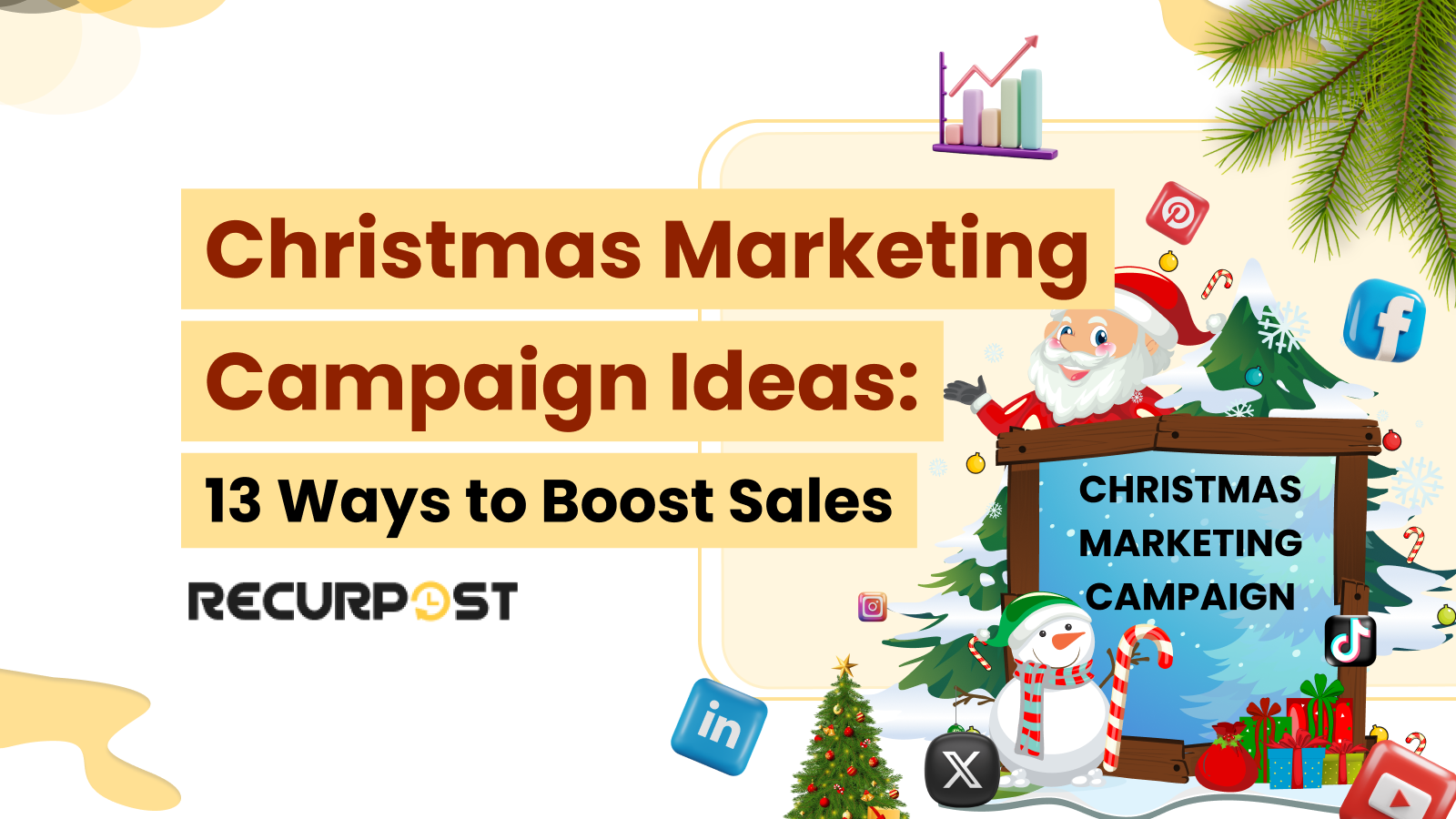Christmas marketing campaigns fail when brands recycle tired themes, while fresh Christmas marketing campaign ideas boost attention. The holiday season drives 40% of retail sales, yet bland Christmas promotions keep many businesses from reaching peak sales.
Standing out in the holiday rush needs creative holiday marketing ideas and seasonal campaigns, from Christmas email marketing to social media posts. Leading brands know Christmas marketing ideas spark more than discounts or snowflake logos; they create lasting Christmas sales boosts and strong audience loyalty.
Here you’ll find 13 Christmas marketing campaign ideas that turn browsers into buyers, perfect for any e-commerce business owner. From holiday campaigns and social media campaigns that drive real engagement to Christmas promotions that capture audience attention, these campaign ideas push holiday sales during the busiest shopping season.
Get ready for Christmas marketing campaign ideas that boost sales, inspire new promotions, and make holiday shoppers remember your brand.
1. Start a Christmas Countdown Campaign
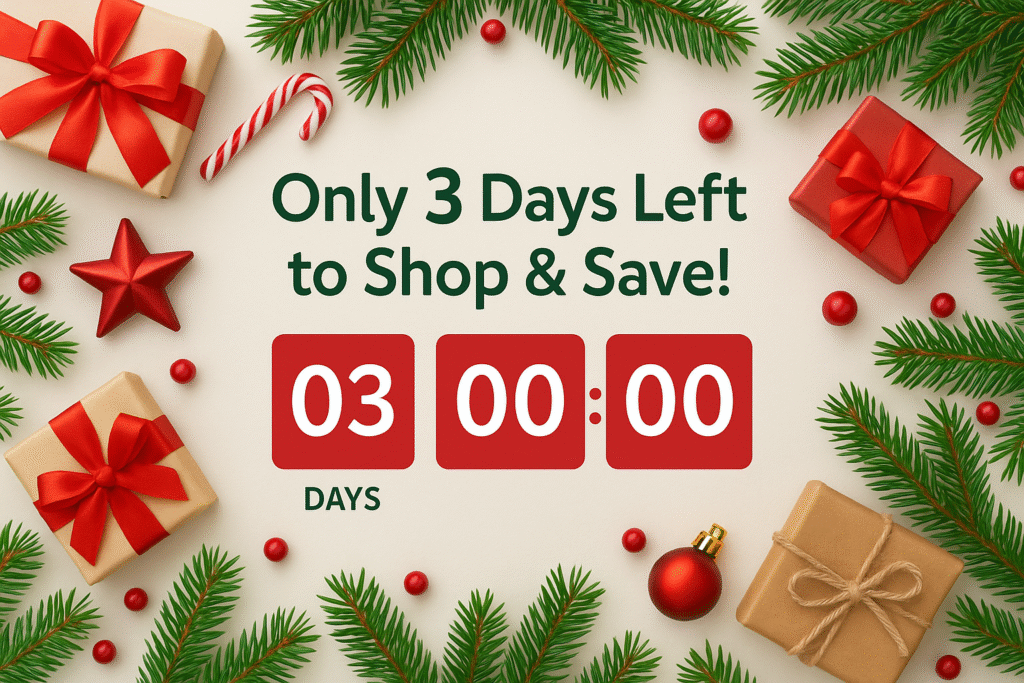
Countdown campaigns are powerful Christmas marketing campaign ideas that turn holiday shopping into fun daily or weekly reveals. Popular forms include digital advent calendars with daily deals, Christmas email marketing series with short-term offers, or countdown clocks that build buzz before sales launch.
Countdown campaigns succeed because they create urgency and add holiday magic. A countdown timer sparks excitement, builds FOMO, and drives quick shopping decisions. Research shows they lift conversion rates by 8.6%. Beyond sales, these holiday campaigns keep brands visible all season and tied to the festive spirit, reminding customers at the right time.
To boost results, share countdowns across social media campaigns, websites, and Christmas email campaigns before launch. Add early-bird deals to spark fast engagement. For small businesses, using simple timers fits perfectly into budget-friendly Christmas marketing campaign ideas without relying on heavy tools.. Adding “last chance” buttons next to timers builds urgency and inspires action during the shopping rush.
2. Design a Holiday Gift Guide
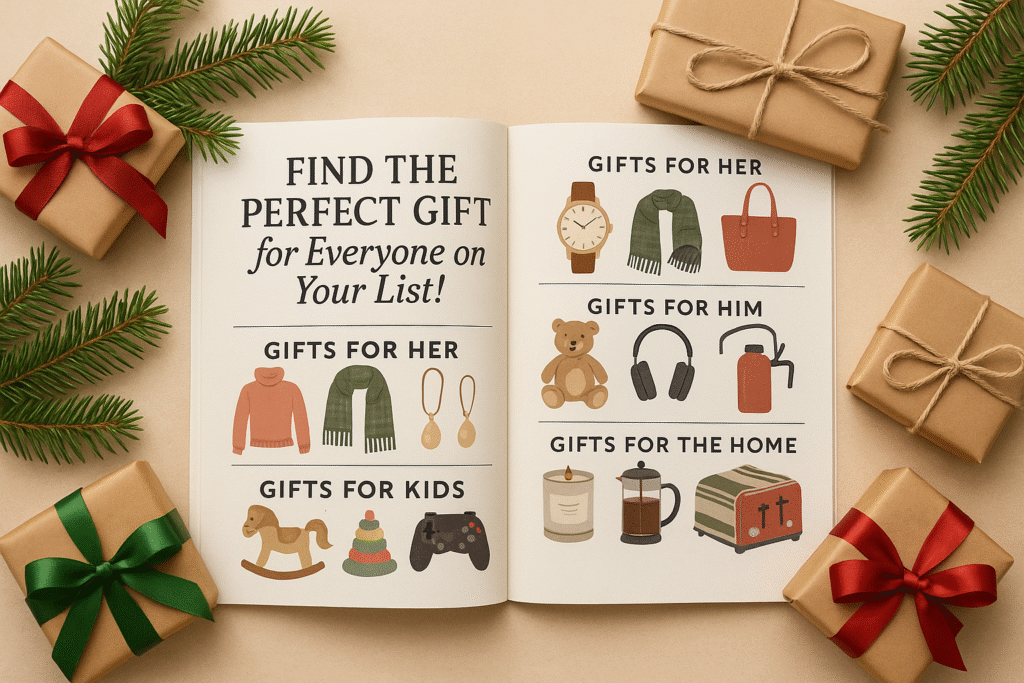
Holiday gift guides remain one of the most trusted Christmas marketing campaign ideas. They help holiday shoppers discover gifts for friends, family, or events through curated lists. Formats for Christmas marketing include:
- Web pages on your e-commerce store
- Christmas email marketing with personalized suggestions
- Social media campaigns showing themed product bundles
- Interactive digital catalogs
The best guides group Christmas-themed products by price, recipient, or current trends. Strong gift guides don’t just list products; they tell stories that make shoppers excited to buy.
Gift guides boost holiday sales by simplifying choices during busy shopping periods. Adding discount codes gives shoppers extra motivation. Christmas email campaigns with guides drive 48% more sales than standard promotions.
Data shows 22% of buyers find gift guides valuable during the Christmas season. They attract early planners(46%) who start shopping in October and last-minute buyers hunting for Christmas gifts, keeping sales strong all season.
3. Free Shipping and Returns: One of the Smartest Christmas Marketing Campaign Ideas

Free shipping removes delivery costs for shoppers at your ecommerce store, while free returns let them send back items with no extra fees. Brands use different holiday marketing ideas for these perks: unconditional free shipping, threshold-based free shipping, seasonal limited-time offers, or loyalty rewards for repeat buyers.
Free shipping and returns strongly shape holiday sales. Research shows 57% of shoppers choose stores based on quick, free delivery during holiday shopping. Around 45% of buyers rank free returns above discounts, making them a valuable part of many Christmas marketing campaign ideas.
These policies add more than convenience, turning simple perks into loyalty drivers and reliable Christmas marketing campaign ideas. When companies offer to cover return shipping costs, customer cart abandonment decreases by 48% making it a strong part of Christmas marketing campaign ideas. By contrast, charging for returns can slash sales 74–100% among past returners.
Cart abandonment proves the value of these campaign ideas. Extra fees cause most buyers to abandon carts, making free shipping important in Christmas marketing. In fact, 83% review return policies before buying, and 71% avoid stores with shipping or restocking charges.
4. Start a Holiday-Themed Email Campaign
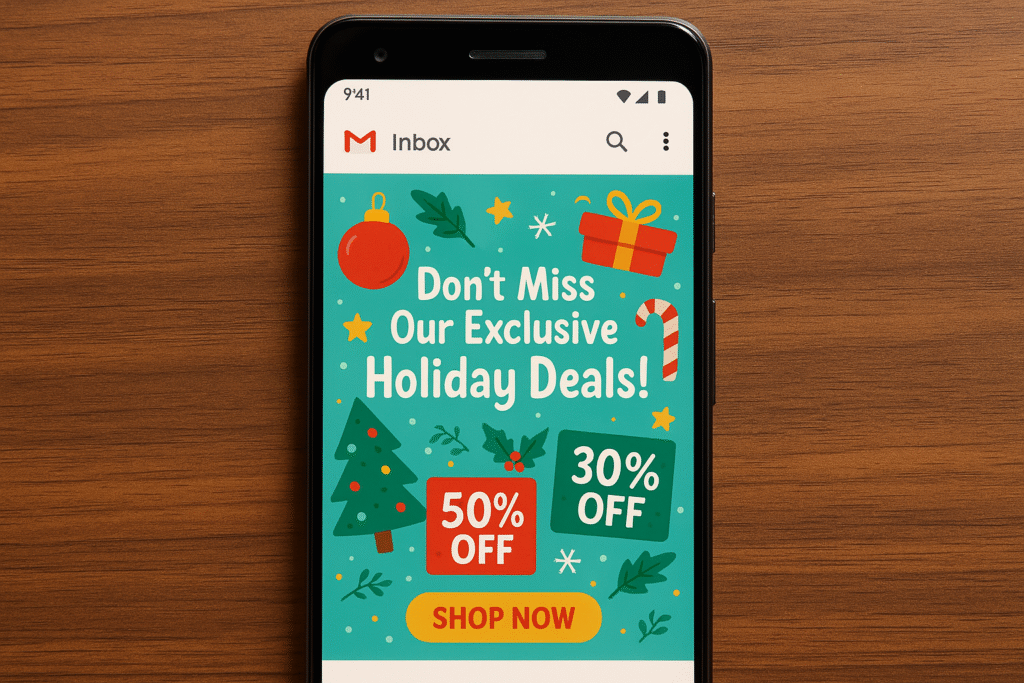
A holiday-themed email campaign is one of the most proven Christmas marketing campaign ideas. It includes festive emails sent across the Christmas season, sometimes even Secret Santa campaigns. Strong sequences feature welcome notes, early-bird deals, gift ideas, limited-time offers, shipping cutoff reminders, and after-holiday updates.
The data proves Christmas email marketing works. Email sent at 7 p.m. drew 9.45% of all opens, and this makes Christmas marketing successful. Targeted holiday emails drive far higher sales compared to generic blasts, boosting holiday campaign success
The reason is clear: shoppers look for holiday deals, so they open festive emails more. With online holiday sales expected to climb 3.5–4.6% in 2025, timed Christmas email campaigns reach early planners and last-minute buyers alike.
5. Bundle Products into Holiday Gift Sets
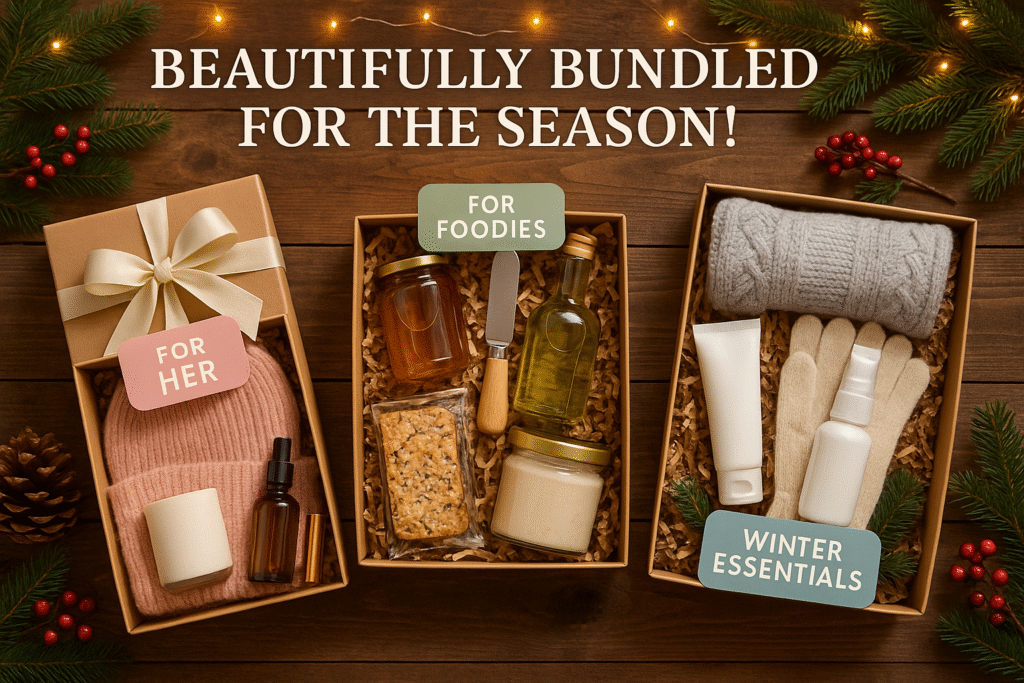
Bundled gift sets are strong Christmas marketing campaign ideas, combining products into festive packages that appeal to holiday shoppers. Types of bundles which can be sold for Christmas include:
- Best-selling bundles: Group top items to match heavy holiday shopping demand
- Themed gift sets: Create ideas like “Cozy Winter Nights” or “Holiday Self-Care” to build festive spirit
- Multi-category bundles: Mix categories to spark interest and build new holiday marketing ideas.
- Discount bundles: Add limited-time holiday promotions to inspire faster purchases
Bundling groups of items into ready-made Christmas bundle groups. It makes gift-giving simple and puts your products in smart combos that catch attention.
Shoppers see more value in bundles, even when savings are small, which is why bundling ranks high among Christmas marketing campaign ideas. That sense of value drives holiday sales when buyers face endless choices.
Bundling is great for customers and for businesses. It keeps sales growing through:
- One benefit of bundling in your Christmas marketing campaign ideas is higher order value as shoppers grab multiple items at once.
- Better profits through pricing and moving slower items
- Smarter Christmas-related stock management
- Visibility for products that shoppers might otherwise skip
6. Use Personalized Packaging and Unboxing
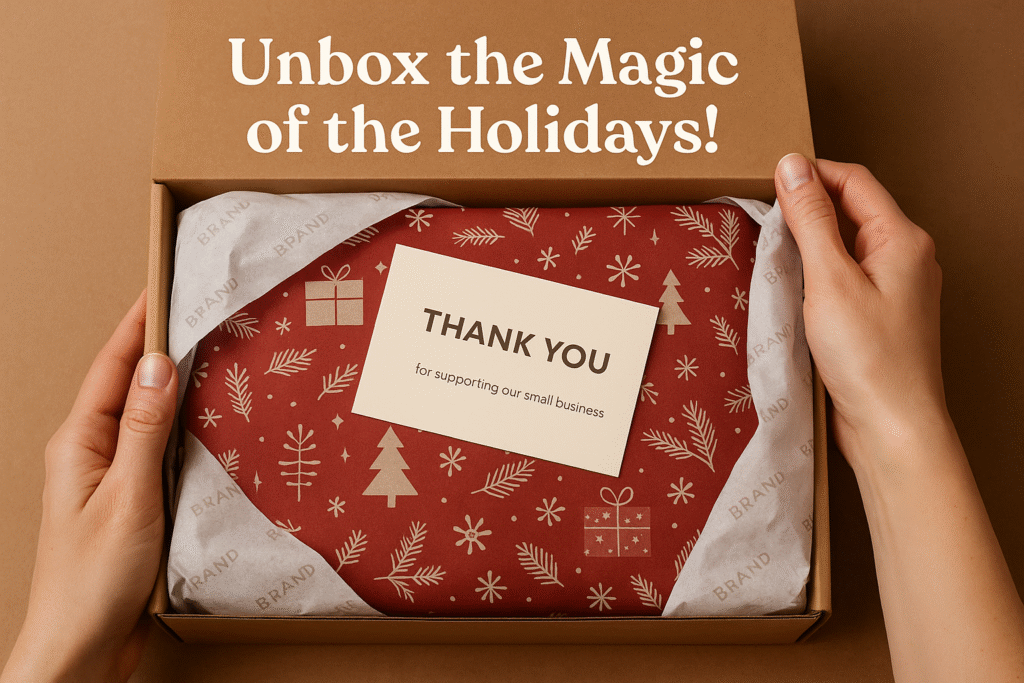
Personalized packaging is another proven Christmas marketing campaign idea. Seasonal packaging with Christmas decorations like holiday stickers, tissue paper, thank-you notes, and themed designs boosts brand connection. Together, these touches make unboxing feel like receiving a Christmas gift, making it a good Christmas marketing idea.
Packaging shapes how buyers see a brand. Research shows 68% of online shoppers feel premium packaging makes a brand look better and is a good choice for gifting occasions like Christmas. Memorable unboxing creates loyalty and inspires social sharing. Unboxing videos trend on YouTube, Instagram, and TikTok, turning customer excitement into free promotion.
Personalized packaging turns the final step of the customer journey into a marketing win. Shoppers often share the experience with friends, social followers, and website visitors, extending the reach of your holiday promotions.
7. Start a Contest for Customer-Created Content

A contest for customer-created content is one of the most engaging Christmas marketing campaign ideas. These contests invite buyers to share holiday experiences with your products. Formats include photo contests in festive settings, video reviews, creative unboxing videos, or holiday-themed stories.
These holiday campaigns usually ask people to use branded hashtags, tag their accounts, or submit entries through simple platforms. Fun challenges include “best decorated Christmas tree” or “most creative gift wrapping” with your products.
UGC contests boost engagement during Christmas shopping, tapping into people’s urge to share. Brands running Instagram contests grow followers 70% faster than those without.
About 84% of buyers trust online reviews like personal recommendations, making customer content valuable during the holiday season. UGC contests also generate steady content that shows products in real use, building loyalty.
You can even use RecurPost Social Media Campaign Templates to create your social media content.
8. Team Up with Influencers for Holiday Content
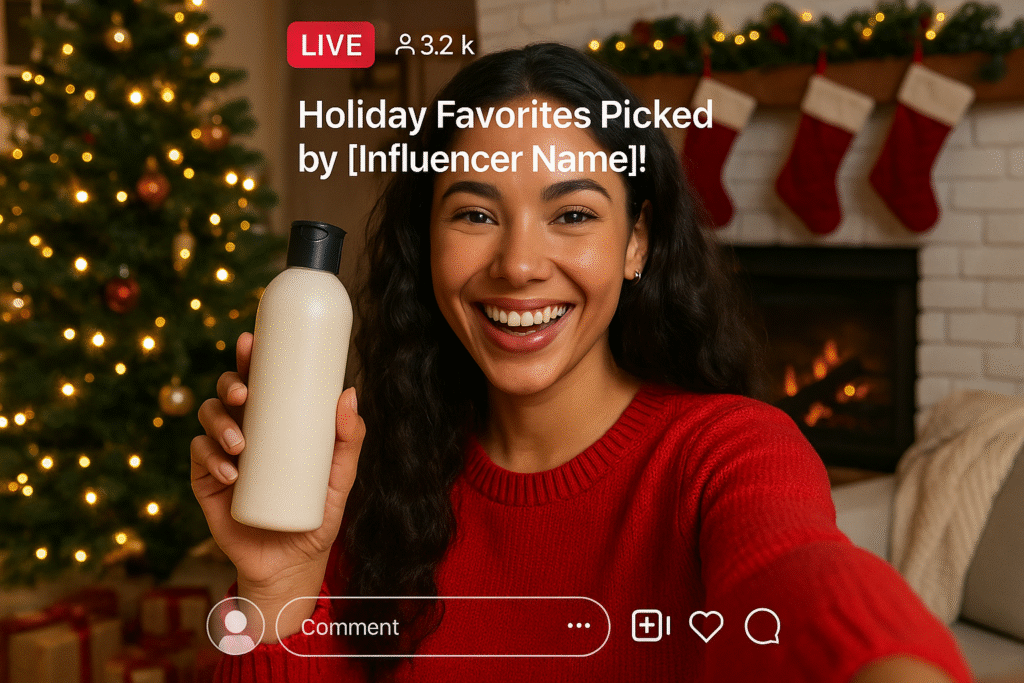
Partnering with influencers is another proven Christmas marketing campaign idea. They create seasonal content such as festive gift guides, holiday-themed unboxings, DIY how-tos, or events like “12 Days of Christmas” campaigns.
A 12-day Christmas marketing campaign works by revealing products, deals, or fun content daily before Christmas. Small businesses can run it through daily social posts or partner with micro-influencers at a lower cost. Each day can showcase a product category, a customer story, or behind-the-scenes updates to keep audiences engaged.
Influencers can spotlight seasonal products in festive settings, creating holiday campaigns that spark interest and build audience trust.
Numbers show why influencers shine during the Christmas season. About 85% of people aged 18–34 prefer influencer content over old channels. Plus, 73% of Gen Z shoppers plan to buy Christmas gifts suggested by influencers. This honest style wins with buyers tired of ad clutter.
9. Set Up a Holiday Pop-Up Shop
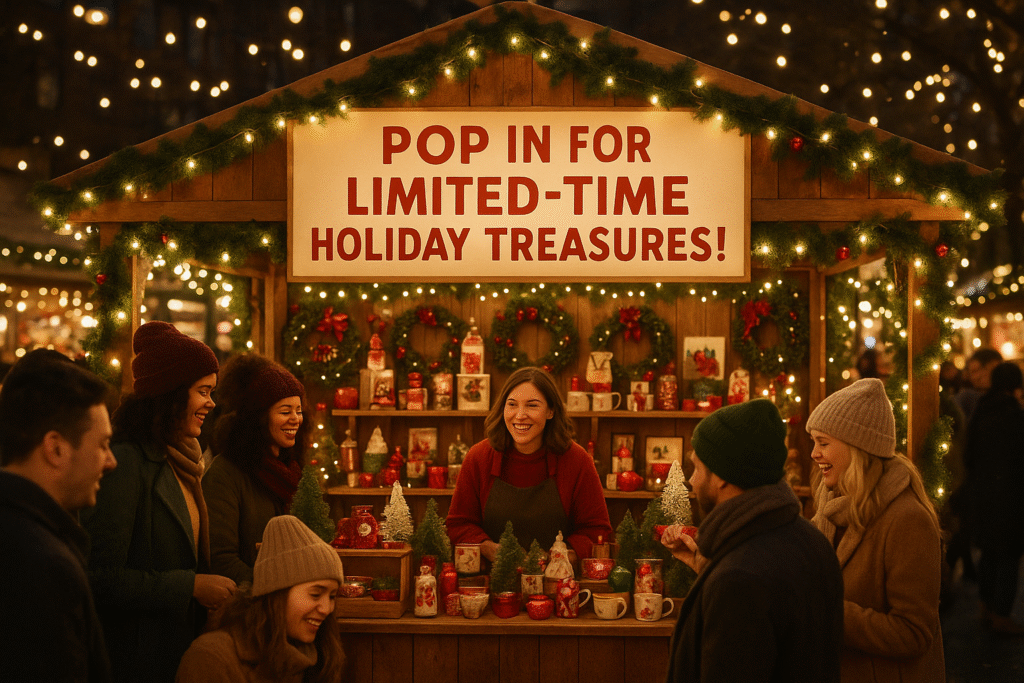
Holiday pop-up shops are creative Christmas marketing campaign ideas, running as temporary retail spaces during the Christmas season. They appear in malls, empty storefronts, markets, or even inside partner businesses. With festive looks and seasonal goods, these shops spark urgency and let brands meet holiday shoppers in person.
During occasions like Christmas, Pop-ups generate up to $80 billion yearly, with 80% of owners seeing results. Beyond profits, they build awareness, test new markets, and form ties with audiences, making them a smart part of Christmas marketing campaign ideas with less risk than permanent stores.
During holidays, perks grow stronger as buyers seek Christmas gifts and festive experiences, sometimes with free gifts. Pop-ups cost about one-fifth of permanent stores, making them perfect for businesses chasing holiday sales without heavy risk. Small shops can test Christmas marketing campaign ideas through weekend stalls, shared spaces, or pop-ups in local stores.
10. Offer Limited-Time Flash Sales
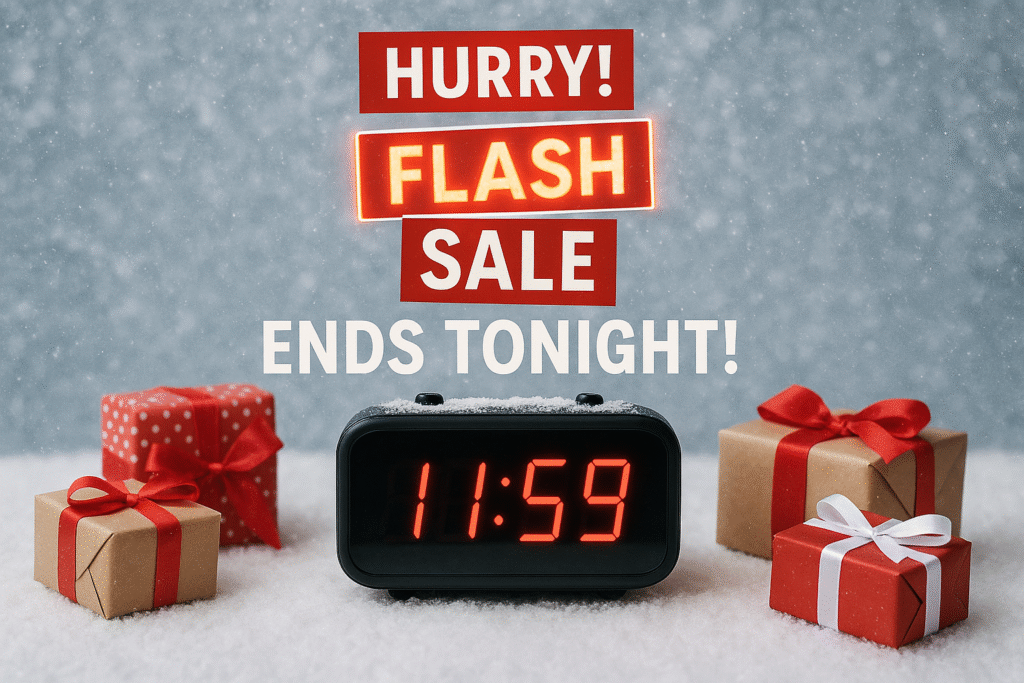
Flash sales are standout Christmas marketing campaign ideas, offering discounts for short windows of hours or days. Strong flash sales are standout Christmas marketing campaign ideas, featuring steep discounts, short buying windows, and limited stock. Holiday flash sales often feature “12-hour Christmas Eve deals” or “weekend-only holiday packages” to drive fast purchases.
Among proven Christmas marketing campaign ideas, flash sales stand out because urgency and limited stock drive buyers to act quickly. These triggers explain why flash sales boost order value by 35%.
Beyond urgency, flash sales clear seasonal stock, bring fast income, raise awareness, and attract new holiday shoppers seeking bargains. Small brands can run them through email lists, social media campaigns, and local communities to spark buzz and sales.
11. Back a Good Cause with Each Sale
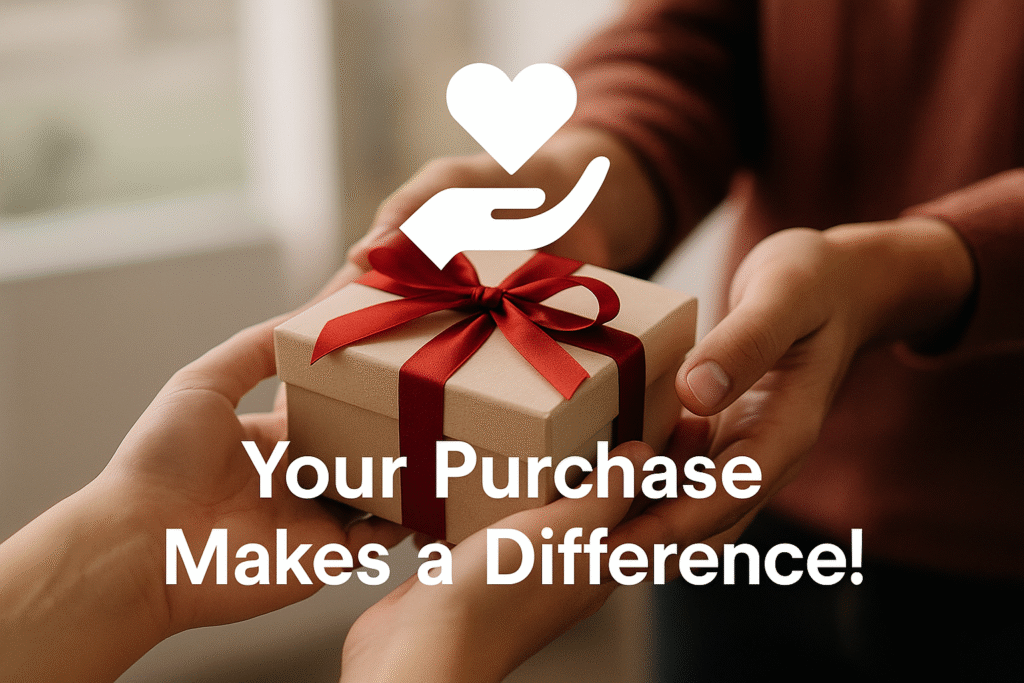
Supporting a cause is one of the most meaningful Christmas marketing campaign ideas. During the Christmas season, brands can:
- Donate part of each sale to a nonprofit
- Launch “Buy One, Give One” plans where each purchase triggers a product donation
- Let customers choose charities linked to their purchases
- Back campaigns that align with your brand values
Showing results of donations helps holiday shoppers see how purchases matter.
Values guide holiday shopping. About 82% of customers choose brands that share their values, showing why cause-based efforts are powerful Christmas marketing campaign ideas. Also, 74% prefer donating to local causes, while 49% buy from brands that back local groups.
Cause marketing does more than help charities: it boosts sales. It gives buyers purpose, grows brand recognition, and builds loyalty by connecting purchases to causes they love.
12. Use Retargeting Ads for Abandoned Carts

Retargeting for abandoned carts is another strong Christmas marketing campaign idea. It shows tailored ads to shoppers who left without buying. These appear across websites or social media campaigns, reminding buyers of items they ditched. Dynamic ads even display exact products left behind on Facebook, Instagram, or Google.
Cart abandonment retargeting works because it blends psychology with results. Dynamic ads show a 0.7% clickthrough rate vs 0.07% for regular ads. Shoppers receiving both retargeting emails and ads are twice as likely to buy.
This method tackles the real reasons for cart abandonment. If shipping fees cause exits, ads can promote free shipping. Timing is powerful: about 69.57% of online shopping carts are abandoned during the holiday season.
13. Add a Holiday Quiz or Gift Finder Tool
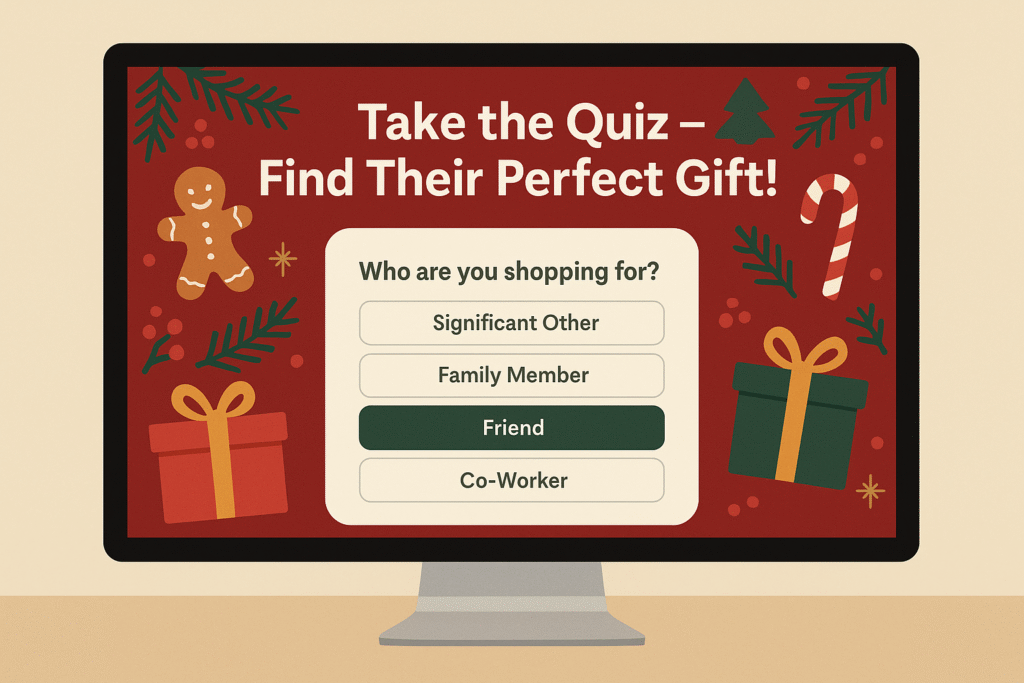
A holiday quiz or gift finder tool is a standout choice among Christmas marketing campaign ideas. These interactive helpers guide shoppers to ideal presents by asking simple questions. You’ll often see them on homepages, menus, or as pop-ups. They gather details like recipient, budget, interests, and style before showing tailored gift ideas. This creates a personal shopping experience, similar to in-store help. Many quizzes also ask for emails, giving brands a way to send more holiday marketing ideas later.
Gift finders succeed because they simplify holiday shopping. Shoppers who take quizzes are three times more likely to buy, making them one of the most engaging Christmas marketing campaign ideas. Quizzes cut down endless options and point buyers toward the perfect Christmas gifts.
Interactive tools perform far better than static content in Christmas marketing. About 81% of marketers say interactive formats grab more attention. Gift finders gather valuable customer journey data while reducing cart abandonment by guiding buyers toward confident purchase decisions.
Conclusion
These 13 Christmas marketing campaign ideas give your brand fresh ways to shine during the holiday season. Each of these Christmas marketing campaign ideas works across social media campaigns, email campaigns, pop-up shops, giveaways, and festive packaging. The more you mix these Christmas marketing campaign ideas into your promotions, the more holiday shoppers notice your products and engage with your brand.
With Christmas marketing campaign ideas ranging from flash sales to quizzes, your content can boost sales, grow loyalty, and spread cheer. RecurPost makes scheduling easy, so you can share these Christmas marketing campaign ideas every day without missing a post.
Merry Christmas and happy selling with your Christmas marketing campaign ideas!
Frequently Asked Questions
1. How can you blend holiday spirit into your everyday branding without seeming forced?
Add small festive touches like a seasonal logo, warm messaging in your Christmas email marketing ideas, or themed visuals on your site. The best Christmas marketing campaign ideas stay joyful and natural, not pushy or sales-heavy.
2. Are Christmas gift cards still popular among younger shoppers?
Yes, they’re more popular than ever, especially for last-minute Christmas shopping. Add digital gift cards to your Christmas marketing campaign ideas so younger audiences can enjoy instant and flexible gifts.
3. Should you create a dedicated landing page for your Christmas gift guide?
Yes, a dedicated page makes browsing easy and helps shoppers buy for occasions like Christmas in one place. It also supports SEO when people search for Christmas gift guide ideas.
4. How do you make your Christmas marketing strategy stand out in a crowded inbox?
Give real value with sneak peeks, early access, or exclusive bundles. During busy times, strong Christmas email marketing ideas give people a reason to open and click.
5. Is it worth promoting products after the main Christmas rush?
Yes, use the post-Christmas window when buyers spend gift cards and look for deals. Smart Christmas marketing campaign ideas include “New Year, New You” or clearance promotions to keep momentum strong.
6. What Christmas marketing ideas work best for small businesses with tight budgets?
Begin with low-cost tactics like social media countdown posts, Christmas email campaigns to current customers, and user contests. Partner with other local businesses for cross-promotion, and personalize experiences instead of competing on steep discounts. A 12-day Christmas marketing campaign on social media, showing different products daily, can create buzz without a big budget.

Shalini Nagar is an experienced content writer with a proven track record of creating diverse and engaging content across various formats. With years of expertise in crafting blogs, articles, she excels at delivering compelling narratives tailored to different audiences.

